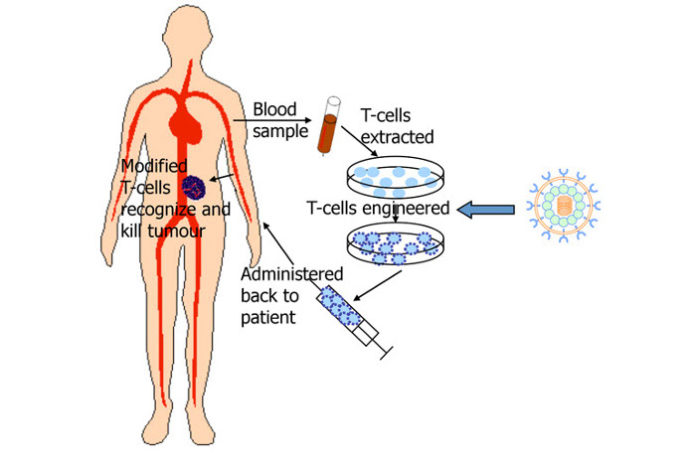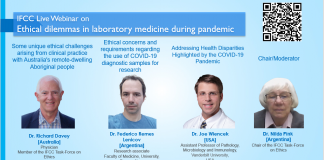Lymphocytes, a subtype of white blood cells, comprise a major portion of the immune system. There are three types of lymphocytes
- B lymphocytes (B cells) make antibodies to fight infection
- T lymphocytes (T cells) and natural killer (NK) cells directly kill infected or cancerous cells and also talk to other cells of the immune system using chemicals known as “cytokines.”
Immunotherapy
- Is a type of treatment that utilizes the body’s own immune system to fight cancer
- Improves the body’s ability to detect and kill cancer cells
- Is based on the concept that immune cells or antibodies can recognize and kill cancer cells.
Immune cells or antibodies can be produced in the laboratory under tightly controlled conditions and then given to patients to treat cancer. Several types of immunotherapy are either approved for use or are under study in clinical trials to determine their effectiveness in treating various types of cancer.
Chimeric Antigen Receptor T-Cell Therapy: How it Works
T cells are collected from a patient. T cells are collected via apheresis, a process that withdraws blood from the body and removes one or more blood components (such as plasma, platelets or white blood cells). The remaining blood is then returned back into the body.
T cells are reengineered in a laboratory. The T cells are sent to a laboratory or a drug manufacturing facility where they are genetically engineered to produce chimeric antigen receptors (CARs) on their surface.
After this reengineering, the T cells are known as “chimeric antigen receptor (CAR) T cells.” CARs are proteins that allow the T cells to recognize an antigen on targeted tumor cells.
The reengineered CAR T cells are then multiplied. The number of the patient’s genetically modified T cells is “expanded” by growing cells in the laboratory until there are many millions of them. These CAR T cells are frozen and, when there are enough of them, they are sent to the hospital or center where the patient is being treated.
At the hospital or treatment center, the CAR T cells are then infused into the patient. Many patients are given a brief course of one or more chemotherapy agents before they receive the infusion of CAR T cells. CAR T cells that have been returned to the patient’s bloodstream multiply in number. These are the “attacker” cells that will recognize, and kill, cancerous cells that have the targeted antigen on their surface.
The CAR T cells guard against recurrence. CAR T cells may remain in the body long after the infusion has been completed. They guard against cancer recurrence, so the therapy frequently results in long-term remissions.
Dr. Brentjens talks about CAR T therapy.
Dr. Steven Rosenberg discusses saving lives with CAR T.
At this time, CAR T-cell therapy is only available to patients who are participating in a clinical trial. Trial protocols vary. Depending on the clinical trial, care may be provided in either a hospital setting or a treatment center. Patients may have to stay at the treatment facility, or they may need to plan to stay close by before, during or following treatment. Some trial protocols require patients to confirm the availability of a caregiver before they can enroll in the trial..
Possible Side Effects of CAR T-Cell Therapy
Cytokine-Release Syndrome (CRS). A serious side effect associated with CAR T-cell therapy is cytokine-release syndrome (CRS). CRS is the result of T-cell activation, so its presence actually indicates a positive response to therapy. Cytokines are chemical messengers that help the T cells perform their duties. With CAR T-cell therapy, large amounts of cytokines are produced by the activated immune system. CRS in this setting may cause high fevers, low blood pressure or poor lung oxygenation (requiring administration of supplemental oxygen as a temporary measure). Some patients experience delirium, confusion and seizure while undergoing treatment. The onset of these symptoms is typically within the first week of treatment. These symptoms, however, are reversible.
B-Cell Aplasia. CAR T-cell therapy targeting antigens found on the surface of B cells not only destroys cancerous B cells but also normal B cells. Therefore, B cell aplasia (low numbers of B cells or absent B cells) is an expected side effect. This absence of B cells results in less ability to make the antibodies that protect against infection. Intravenous immunoglobulin replacement is used to prevent infection. It is not known how long the decreased number of B cells persists however, no long-term side effects have been noted.
Tumor Lysis Syndrome (TLS). Another known side effect of CAR T-cell therapy is tumor lysis syndrome (TLS), a group of metabolic complications that can occur due to the breakdown of dying cells—usually at the onset of toxic cancer treatments. However, TLS can occur one month or more after CAR T-cell therapy. TLS can be a life-threatening complication of any treatment that causes breakdown of cancer cells, including CAR T cells. The complication has been managed by standard supportive therapy.
Results, Limitations, and the Future of CAR T-cell Therapy
Early results from CAR T-cell trials have generated impressive results and considerable promise in patients with blood cancers.
Acute lymphoblastic leukemia (ALL). CAR T-cell therapy may represent options for ALL patients who have relapsed after intensive chemotherapy or a stem cell transplant. In some studies, up to 90 percent of children and adults with ALL who had either relapsed multiple times, or failed to respond to standard therapies, achieved remission after receiving CAR T-cell therapy.
Other blood cancers. Studies of CAR T-cell therapy in other blood cancers, including chronic lymphocytic leukemia (CLL), some types of non-Hodgkin lymphoma (NHL) including diffuse large B cell lymphoma (DLBCL) and follicular lymphoma, as well as multiple myeloma, are also very promising.
While data is fast emerging as to the early responses to CAR T-cell therapy, most of the patients participating in these clinical trials have only been followed for a relatively short period of time. Following these trial participants over the long term will provide information as to the length of their responses. It is important for more pediatric and adult patients to be enrolled in clinical trials. Larger study samples, looked at over more extended periods, will help researchers further understand the impact of this type of therapy, ways to reduce its toxicity and also improve toxicity management.
Enrolling in a Trial
Talk with your doctor about whether participation in a CAR T-cell therapy clinical trial is an option for you. Obtaining another opinion from a hematologist–oncologist (a blood cancer specialist), may be helpful in finding additional clinical-trial information as well. When you discuss CAR T-cell therapy as a potential treatment option for you, it may be helpful to have
- A list of questions to ask concerning risks versus benefits of such a trial (click here for lists of suggested questions).
- A family member, friend, or another advocate with you for support and to take notes.
In addition to speaking with your doctor, LLS Information Specialists, available at (800) 955-4572, offer guidance on how patients can work with their doctors to determine if a specific clinical trial is an appropriate treatment option. Information Specialists can search for clinical trials on behalf of patients, family members and healthcare professionals.
Source: lls.org











